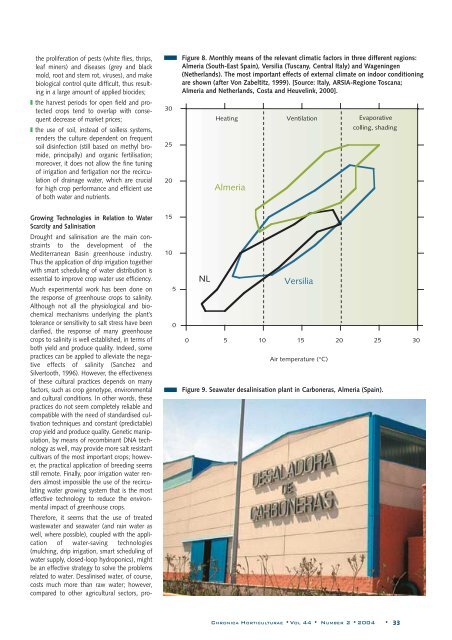Number 2 - 2004 - Acta Horticulturae
Number 2 - 2004 - Acta Horticulturae
Number 2 - 2004 - Acta Horticulturae
Create successful ePaper yourself
Turn your PDF publications into a flip-book with our unique Google optimized e-Paper software.
the proliferation of pests (white flies, thrips,<br />
leaf miners) and diseases (grey and black<br />
mold, root and stem rot, viruses), and make<br />
biological control quite difficult, thus resulting<br />
in a large amount of applied biocides;<br />
❚ the harvest periods for open field and protected<br />
crops tend to overlap with consequent<br />
decrease of market prices;<br />
❚ the use of soil, instead of soilless systems,<br />
renders the culture dependent on frequent<br />
soil disinfection (still based on methyl bromide,<br />
principally) and organic fertilisation;<br />
moreover, it does not allow the fine tuning<br />
of irrigation and fertigation nor the recirculation<br />
of drainage water, which are crucial<br />
for high crop performance and efficient use<br />
of both water and nutrients.<br />
30<br />
25<br />
20<br />
Figure 8. Monthly means of the relevant climatic factors in three different regions:<br />
Almeria (South-East Spain), Versilia (Tuscany, Central Italy) and Wageningen<br />
(Netherlands). The most important effects of external climate on indoor conditioning<br />
are shown (after Von Zabeltitz, 1999). [Source: Italy, ARSIA-Regione Toscana;<br />
Almeria and Netherlands, Costa and Heuvelink, 2000].<br />
Heating Ventilation Evaporative<br />
colling, shading<br />
Almeria<br />
Growing Technologies in Relation to Water<br />
Scarcity and Salinisation<br />
Drought and salinisation are the main constraints<br />
to the development of the<br />
Mediterranean Basin greenhouse industry.<br />
Thus the application of drip irrigation together<br />
with smart scheduling of water distribution is<br />
essential to improve crop water use efficiency.<br />
Much experimental work has been done on<br />
the response of greenhouse crops to salinity.<br />
Although not all the physiological and biochemical<br />
mechanisms underlying the plant’s<br />
tolerance or sensitivity to salt stress have been<br />
clarified, the response of many greenhouse<br />
crops to salinity is well established, in terms of<br />
both yield and produce quality. Indeed, some<br />
practices can be applied to alleviate the negative<br />
effects of salinity (Sanchez and<br />
Silvertooth, 1996). However, the effectiveness<br />
of these cultural practices depends on many<br />
factors, such as crop genotype, environmental<br />
and cultural conditions. In other words, these<br />
practices do not seem completely reliable and<br />
compatible with the need of standardised cultivation<br />
techniques and constant (predictable)<br />
crop yield and produce quality. Genetic manipulation,<br />
by means of recombinant DNA technology<br />
as well, may provide more salt resistant<br />
cultivars of the most important crops; however,<br />
the practical application of breeding seems<br />
still remote. Finally, poor irrigation water renders<br />
almost impossible the use of the recirculating<br />
water growing system that is the most<br />
effective technology to reduce the environmental<br />
impact of greenhouse crops.<br />
Therefore, it seems that the use of treated<br />
wastewater and seawater (and rain water as<br />
well, where possible), coupled with the application<br />
of water-saving technologies<br />
(mulching, drip irrigation, smart scheduling of<br />
water supply, closed-loop hydroponics), might<br />
be an effective strategy to solve the problems<br />
related to water. Desalinised water, of course,<br />
costs much more than raw water; however,<br />
compared to other agricultural sectors, pro-<br />
15<br />
10<br />
5<br />
0<br />
NL<br />
Versilia<br />
0 5 10 15 20 25 30<br />
Air temperature (°C)<br />
Figure 9. Seawater desalinisation plant in Carboneras, Almeria (Spain).<br />
CHRONICA HORTICULTURAE •VOL 44 • NUMBER 2 • <strong>2004</strong> • 33
















